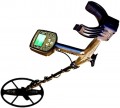Frequency
The characteristics of the installed coil determine the operating frequency of the metal detector. See "Detection frequency" for more details.
Dimensions (WxD)
The size of the standard coil (frame) of the metal detector. Theoretically, the larger it is, the deeper the device is able to “see” and the more space it captures in one pass, but the worse it is suitable for searching for small objects and the lower the accuracy with which it localizes them. At the same time, these characteristics depend on so many other factors that in fact, the size of the coil itself affects them very little.
Note that for coils (frames) of an elliptical shape, only one size can be indicated — along the length.
Number of coils
The number of coils provided in the scope of delivery of the metal detector.
Emitter-coils are used in metal detectors with all operating principles (see above), except for RF (frames are more justified for them). Also note that, unlike the frames, such emitters are installed only one at a time, and even a paired DD type emitter (see "Coil type") is considered one coil. So if there are several coils in the kit, this means that they are interchangeable. Such a complete set is convenient in that it allows you to choose a working nozzle depending on the specifics of the situation. For example, for the initial search, you can use a large coil, with low accuracy and wide coverage; and having found something interesting, you can put a "sniper" attachment and determine the exact location of the find. However, the features of such a configuration may be different, interchangeable coils may have a specialization in metals, soil types, etc., and it's ok to clarify their features separately before buying.
Also note that some models may not be equipped with coils at all. On the one hand, this means additional efforts to select and purchase these parts, on the other hand, it allows you to choose them yourself according to your own requirements, without relying on the manufacturer's decisions. This option is useful for advanced "treasure hunters".
Number of detection frequencies
The number of individual operating frequencies at which the metal detector can operate. For more on the frequencies themselves, see "Detection Frequency" below; here we note that the more options (
3 frequencies and more) are provided in the design, the wider the capabilities of the metal detector, the easier it is to adjust it to the specifics of the objects being searched and the environment. However, most models have
one frequency.
Detection frequency
The operating frequency (or frequency range) of the metal detector. This is one of the most important parameters when choosing a device, because the optimal frequency for different cases will be different — depending on the size and material of the items being searched, the characteristics of the soil and other factors. Detailed recommendations on the choice of frequency for each specific situation can be found in special sources; And already on the basis of this information, it is worth choosing a specific model.
Note that the actual frequency at which the metal detector will operate also depends on the installed coil — they are usually made for a specific frequency. Therefore, to use the full capabilities of the device with the ability to adjust this parameter, you may need replaceable coils.
Max. detection depth
The greatest depth at which a metal detector is guaranteed to be able to detect a metal object. Note that this parameter is most often quite approximate, moreover, somewhat conditional. This is due to the fact that it is usually indicated for an perfect environment (low-mineralized soil, a fairly large object, the material of which optimally matches the frequency of detection of the coil, etc.), and even for such conditions it is difficult to derive an absolutely accurate value. Therefore, in fact, the detection depth is highly dependent on a number of additional factors (from soil characteristics to user skills) and can be significantly less than indicated in the characteristics. Nevertheless, the claimed depth describes the capabilities of the metal detector quite well, and it is quite possible to compare different models with each other.
Note that a large depth not only increases the cost of the device, but can also adversely affect its ability to detect small objects.
Coin detection depth
The deepest depth at which a metal detector is capable of detecting small coins and other objects of similar size. Many users buy a device with the intention of “hunting” for metal trifles, so manufacturers often indicate this parameter separately in the specifications. Due to the small size of the coins, their detection depth is usually much less than the total maximum detection depth (see above).
Discrimination segments
The number of individual discrimination programs provided in the design of the metal detector. In this case, discrimination means filtering the detected objects using a discriminator (see above) so that the device does not work on unwanted objects such as pieces of foil, bottle caps, etc. You can also configure such a filter completely manually, but this may require special knowledge and create difficulties for inexperienced users. To avoid this, some models may have preset programs instead of manual settings. Thanks to such programs, the user just needs to select from the list what type of objects the metal detector should react to, and all the necessary settings will be set by the device's electronics.
Number of modes
The number of pre-installed programs for searching for various materials. Their number reflects the capabilities of a particular model, allowing you to start working right off the bat.

